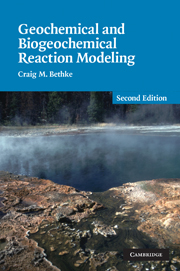Book contents
- Frontmatter
- Contents
- Preface
- Preface to first edition
- A note about software
- 1 Introduction
- 2 Modeling overview
- Part I Equilibrium in natural waters
- Part II Reaction processes
- Part III Applied reaction modeling
- 22 Hydrothermal fluids
- 23 Geothermometry
- 24 Evaporation
- 25 Sediment diagenesis
- 26 Kinetics of water–rock interaction
- 27 Weathering
- 28 Oxidation and reduction
- 29 Waste injection wells
- 30 Petroleum reservoirs
- 31 Acid drainage
- 32 Contamination and remediation
- 33 Microbial communities
- Appendix 1 Sources of modeling software
- Appendix 2 Evaluating the HMW activity model
- Appendix 3 Minerals in the LLNL database
- Appendix 4 Nonlinear rate laws
- References
- Index
26 - Kinetics of water–rock interaction
Published online by Cambridge University Press: 05 August 2012
- Frontmatter
- Contents
- Preface
- Preface to first edition
- A note about software
- 1 Introduction
- 2 Modeling overview
- Part I Equilibrium in natural waters
- Part II Reaction processes
- Part III Applied reaction modeling
- 22 Hydrothermal fluids
- 23 Geothermometry
- 24 Evaporation
- 25 Sediment diagenesis
- 26 Kinetics of water–rock interaction
- 27 Weathering
- 28 Oxidation and reduction
- 29 Waste injection wells
- 30 Petroleum reservoirs
- 31 Acid drainage
- 32 Contamination and remediation
- 33 Microbial communities
- Appendix 1 Sources of modeling software
- Appendix 2 Evaluating the HMW activity model
- Appendix 3 Minerals in the LLNL database
- Appendix 4 Nonlinear rate laws
- References
- Index
Summary
In calculating most of the reaction paths in this book, we have measured reaction progress with respect to the dimensionless variable ξ. We showed in Chapter 16, however, that by incorporating kinetic rate laws into a reaction model, we can trace reaction paths describing mineral precipitation and dissolution using time as the reaction coordinate.
In this chapter we construct a variety of kinetic reaction paths to explore how this class of model behaves. Our calculations in each case are based on kinetic rate laws determined by laboratory experiment. In considering the calculation results, therefore, it is important to keep in mind the uncertainties entailed in applying laboratory measurements to model reaction processes in nature, as discussed in detail in Section 16.2.
In the next chapter (Chapter 27) we show calculations of this type can be integrated into mass transport models to produce models of weathering in soils and sediments open to groundwater flow. In later chapters, we consider redox kinetics in geochemical systems in which a mineral surface or enzyme acts as a catalyst (Chapter 28), and those in which the reactions are catalyzed by microbial populations (Chapter 33).
Approach to equilibrium and steady state
In Chapter 16 we considered how quickly quartz dissolves into water at 100°C, using a kinetic rate law determined by Rimstidt and Barnes (1980). In this section we take up the reaction of silica (SiO2) minerals in more detail, this time working at 25°C. We use kinetic data for quartz and cristobalite from the same study, as shown in Table 26.1.
- Type
- Chapter
- Information
- Geochemical and Biogeochemical Reaction Modeling , pp. 387 - 404Publisher: Cambridge University PressPrint publication year: 2007



